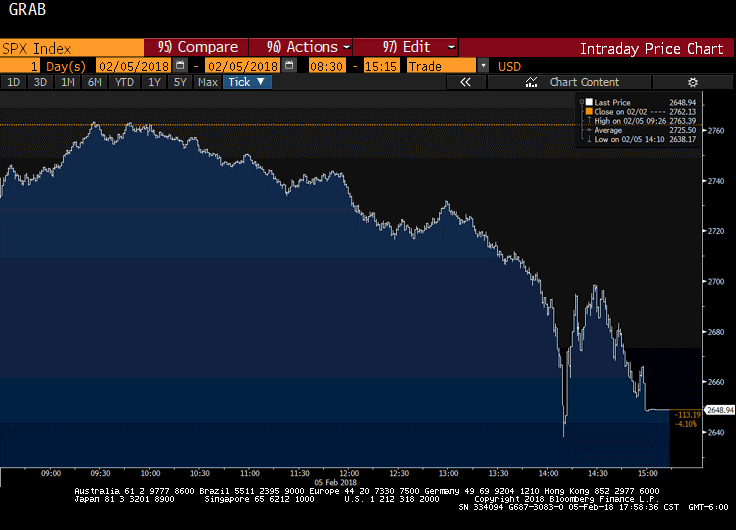The S&P 500 lost more than four percent, the largest single day loss for the index since August, 2011. The losses started out modestly through lunchtime, but accelerated sharply in the early afternoon.
At one point, as seen in the Bloomberg screenshot below, the S&P 500 spiked higher, but then lost back everything that was earned in the final hour or so of trading. Although we don’t know exactly what happened, I suspect that the accelerated losses were the result of forced liquidations by leveraged investors and the spike was due to algorithmic trading.

One of the most defining features of the day was the enormous spike in expected volatility, which more than doubled from the day before. Expected volatility is measured by the CBOE Volatility Index, which is based on prices from S&P 500 options contracts.
We’ve been writing about the unusually low level of expected and realized volatility for some time now (click here, here and here for more), but that regime ended abruptly yesterday. The chart below is another screenshot from Bloomberg, which shows the VIX index for the last five years.
Although the jump yesterday was the largest single day move in the index’s history (which dates back to 1993), you can see that the level is not at all unprecedented. In fact, you can see that volatility spiked this high as recently as 2015 and faded away relatively quickly. If the chart dated back to 2008, you’d see that the VIX traded well above 100 on some days.

One of the interesting and somewhat amazing things about this downdraft is that there was no specific news that turned the market.
The catalyst appears to be the ongoing losses in the bond market this year, which were the result of higher inflation expectation due to stronger expected economic growth – the same thing that was sending stocks higher.
At this point, I think it’s useful to remember a few things to help deal with lower stock and bond prices and higher volatility.
- Remember your time horizon. If you own stocks, its because you have a long-term time horizon, measured in years or, more likely, decades. The day-to-day machinations take up more attention than they deserve. Will you remember five years from now that the losses in the first few days of February basically offset what happened in January? Did you remember the spike in volatility from 2015?
- Put the losses in context. Just last year, the S&P 500 was up 21.8 percent. Even with yesterday, the loss for the year is less than one percent. The ten year return, including yesterday and the -37.0 percent loss in 2008 is still 9.4 percent.
- Your investments are boring: stocks and bonds. Yes, they’ve both lost money, but you’re not leveraged or invested in esoteric strategies that are taking it on the chin. As I noted above, I believe that the wave of selling this afternoon was related to forced liquidations by leveraged traders. We very occasionally use margin for clients to meet very short-term cash flow needs, but other than that, we don’t use leverage. The changes in the VIX affect trading strategies, but for us, is mostly just a measure of how hard we’re clenching our teeth.
- You don’t know what’s going to happen next. It’s easy to extrapolate all kinds of bad things that can happen, but you could have done that with the two back-to-back 10 percent corrections in 2015 and 2016 that each reversed themselves before the quarter was over. I’m not saying that history will repeat itself, but I am saying that you never know.
- We’ve planned for this. All of our financial planning accounts for market volatility. We know that this will happen, we just never know the when or the why in advance (sometimes, we’re not sure of the why even after the fact). Remember that long document that we made you sign called the Investment Policy Statement (IPS)? It outlines your goals and objectives and spells out that losses like this have happened before and will happen again. It’s part of the plan.
Hopefully markets will calm down tomorrow and we can get back to the abbreviated market summaries. Until that happens, though, we’ll be back each day with what’s happening and some thoughts that we hope you find useful.


